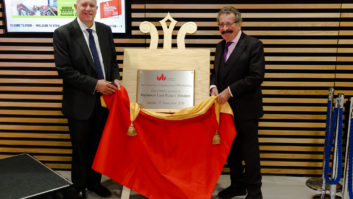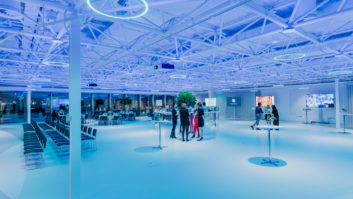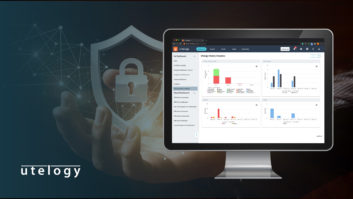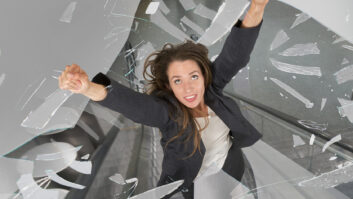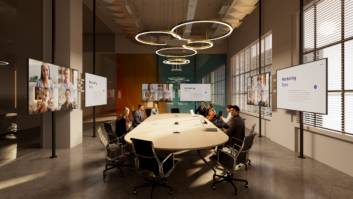About 12 months ago Installation explored the state of the visitor attractions and live events markets in the wake of the pandemic. Whilst the outlook wasn’t without caveats, the overall impression was of a robust return to form, with many visitor attraction and live venue operators evincing a strong desire to engage with new technologies.
One year on and that trend has become even more apparent. No doubt there are commercial considerations here; a cost of living crisis that shows no signs of dissipating has meant that the competition for consumer spending is intensifying. Then, as seen with the recent controversy over ticketing for Oasis’ 2025 tour, there is the whole issue of dynamic or surge pricing in live events – something that surely has the capacity to seriously discourage the next generation of concertgoers if it’s not addressed soon.
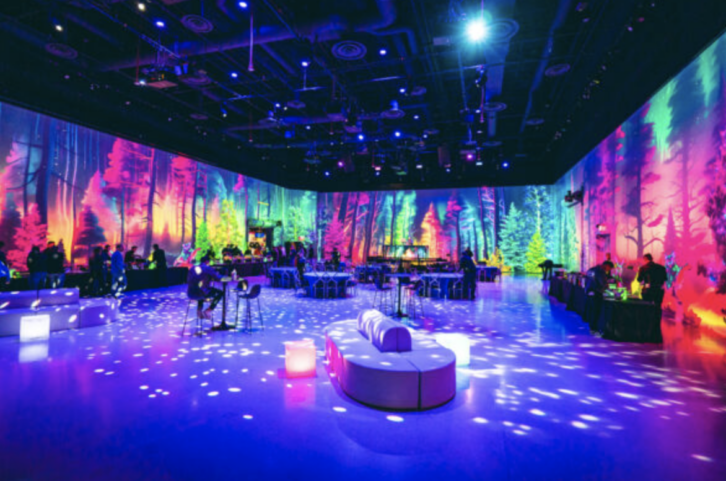
ENHANCING ATTRACTIONS
But in addition to these revenue-related factors, there is also much evidence of a genuine desire to enhance attractions and events with new technologies – from immersive audio environments at festivals to full-on son et lumière outdoor exhibitions harnessing the latest projection and display solutions. In this latest overview, we look at some of the specific technologies becoming more commonplace across visitor attractions and live events, but we commence with a brief reflection on business over the last 12 months.
Digital Projection manufactures an extensive line of high-performance 3-chip and single-chip DLP projection systems. The company’s VP of global marketing, Mark Wadsworth, alludes to a huge demand across market sectors for technology that supports more compelling experiences.
“Both [visitor attractions and live events] are arguably some of the strongest markets in the last year or two, with projects ranging from high-end restaurants that need to turn dinner into a true experience, to traditional mappings and attractions that immerse you in history and tell a story,” he says. “No longer is a visitor attraction just something that you passively experience, it is something that you participate in, something that activates all the senses to tell a story, and the audio video industry is pivotal in providing the technology to achieve this.”
HOLOPLOT – a company specialising in multi-dimensional audio whose technology boasted a high-profile installation in September 2023 with the opening of The Sphere in Las Vegas – also reports a strong outlook, with head of business development Francois Villaret indicating entertainment venues are taking a lead from visitor attractions.
“From our viewpoint, demand is steadily increasing and, as manufacturers of flexible, scalable solutions for all kinds of applications, we have seen a shift in the way that entertainment venues are treating their audiences,” he says. “Very much borrowed from the visitor attraction industry, entertainment venues are realising that audiences have a level of expectation that goes beyond the auditorium, starting the moment they set foot in the venue. [Hence] we are seeing a trend towards larger, more immersive systems that form part of a holistic approach to visitors’ experiences.”
Another company that can surely attest to the demand for a ‘holistic’ approach to attractions and events is Naostage, which designs and develops innovative tracking technologies and equipment for stage, audio, lighting and video professionals. CEO and founder Paul Cales highlights interest across markets in its flagship product, K SYSTEM, which he describes as the world’s first automatic, beaconless 3D tracking solution.
“We’ve seen great demand for our K SYSTEM from both visitor attractions and live events customers over the past 12 months, indicating a healthy market for the rental/staging sector, festivals, and the myriad types of installations, and a thirst for disruptive solutions that help improve a show, as well as reduce manpower and costs,” he says. “In particular, the festival market remained strong, despite economic challenges, with K SYSTEM being used to automate spectacular AVL effects at over a dozen festivals and events this summer.”
RAISED EXPECTATIONS
Howard Jones, communications director at loudspeaker manufacturer Genelec, points to a general raising of expectations post-Covid. “When people were confined at home they bought a new TV, or new sound equipment, and realised they can now experience really good entertainment in the home,” he says. “So since people have had the potential to go out and spend money again, [they have felt] that these experiences have to be really good. [Operators] have therefore realised that making sure the quality of the visuals and audio is great is part of getting people to come through the door.”
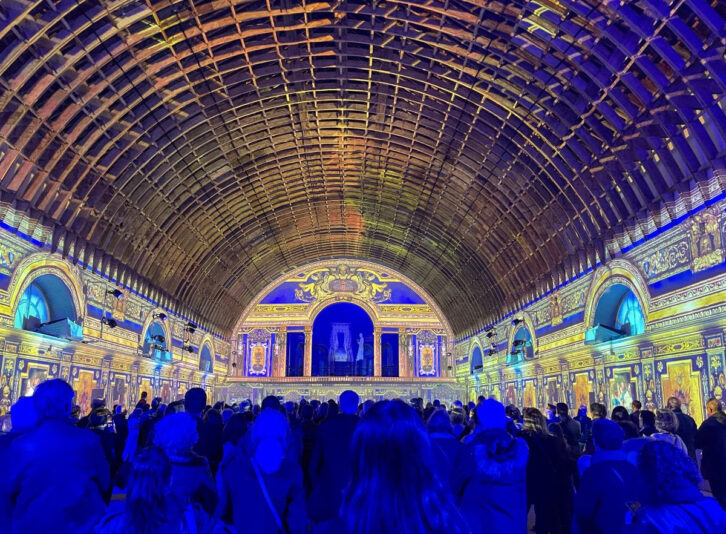
Digital Projection lit up the Lights on Louis XIII show in Saint-Germain-en-Laye, France
Lorenzo De Poi, brand manager at audio solutions company K-array, points to recent projects including all-day tourist attraction Pier 5 in Miami and Sea World Abu Dhabi as examples of technology allowing people to have the experiences they are now craving. “For sure, tourist attractions is a bigger business for us at the moment, but [on the live side] in addition to the large festivals being back, there are also many other events where there is a lot of attention to detail; [in other words] minor events that are not as small as they used to be,” he comments.
All things considered, it seems like the underlying market conditions are pretty strong now, and therefore conducive to investment by operators and their backers – but what are the primary factors determining how they allocate their funds?
SERVING CREATIVITY
For Wadsworth, the industry keeps evolving, and there is a constant push for something new. “Take Abba Voyage, for example, or any other concert that has taken advantage of creating digital avatars. These are pushing the boundaries, using all AV technology, to give visitors something new and exciting they haven’t seen before,” he observes.
But there is a significant caveat, which is that without careful – and, critically, original – thought – the results can still be underwhelming despite all the bells and whistles. “Technology is only an enabler; it is the creative use of it that is key to filling attractions,” notes Wadsworth. “Simply putting on a holographic show or mapping a building without a reason, or a point of unique difference, will not wow the audience like a well thought-out and constructed narrative will.”
For an instance where technology is fully in the service of creativity, he points to the recent project involving both Digital Projection and Naostage – Le Mime et L’Étoile – a new theatrical spectacle at famed French theme park Puy du Fou that utilises the latest AV technology to transport audiences back to the ‘Belle Époque’. This is the term used for the period between the end of the Franco-Prussian War in 1871 and the outbreak of World War I in 1914 which was characterised by prosperity, cultural enlightenment, and scientific innovation.
Whilst Digital Projection’s Satellite Modular Laser System (MLS) delivers visual content, Naostage handles the tracking of actors to create lighting, sound and visual effects on the stage.
Wadsworth notes: “Puy du Fou is without a doubt one of our flagship visitor attractions projects, where our technology was pivotal to the immersivity for this show, which has already been recognised by a number of industry awards. [Amsterdam multimedia installation project] Vincent Meets Rembrandt is also worth mentioning as it achieved the tour de force of turning old buildings into a canvas, and where new projection technology acted as the brush and paint.”
For Naostage, Cales observes that the use of cutting-edge AV technologies to bring exhibitions and amusements to life is key to creating the immersion that attendees now increasingly demand from visitor attractions of all kinds. Along with the raised post-pandemic expectations of visitors, he believes the global chip shortage of 2021-2023 has made it more important than ever for attractions to invest in the right technologies.
CRUCIAL CHARACTERISTICS
One of the ways in which technology developers seem to be responding to this need for carefully calibrated solutions is an increased emphasis on ease of integration for both the attraction and other core technologies.

Alluding to the aforementioned Digital Projection Satellite MLS system, Wadsworth says it enables projectors to go where previously you could not fit one. “This opens up the possibility for creativity that was previously not possible [due] to space constraints. In order to feel fully immersed, visitors need to focus on the content, not on the hardware, which has to be forgotten both visually and in terms of noise levels,” he says.
Flexibility that supports a potentially wide range of event formats and types – and therefore allows it to have a significant degree of future-proofing – is another important consideration, indicates Villaret: “The purchase of a loudspeaker system is a fundamental choice for any venue, regardless of size. An important factor has to be the flexibility of an installed system. It needs to be future-proof to be cost-effective.
Venues need to optimise their revenue streams, including a more diverse programme and utilisation of their space layout, while reducing changeover times between shows,” he says. “That is why we made HOLOPLOT systems supremely flexible. Once installed, they can be adjusted via the software, either to programmed presets, or for new requirements without ever touching the hardware.”
And as Villaret previously indicated, it’s a requirement that is increasingly sought across visitor attractions and live events. “We recently deployed a system at Tomorrowland electronic music festival in Belgium, for their immersive Atmosphere stage,” he notes. “The festival is an excellent example of the immersive thinking behind truly successful events and shows the benefit of valuing the acoustic experience of visitors and concert audiences.”
He also sees a trend towards putting immersive exhibitions, events and attractions into repurposed existing spaces, which come with fundamental acoustic challenges – Lightroom London being an example. “HOLOPLOT’s sound control capabilities address these problems, while offering a versatile toolset to support creative visionaries in delivering memorable experiences,” he observes.
CONTINUED PERMEATIONS
Flexibility and ease of configuration requirements are also ensuring that IP-based audio continues to permeate our two featured markets. For Genelec, Jones points to the company’s Smart IP range of networked active loudspeaker systems that deliver audio, power and loudspeaker management over a single CAT cable. “They are popular because they are compact and you’ve great coverage both on- and off-axis,” he says. “Also, the single CAT cable [design] means that if you’re looking at big multi-channel systems, there is obviously going to be a lot less cabling. We do see the future as being [about] more and more networked installations, so we feel that we are quite well-positioned for that trend.”
K-array’s De Poi also alludes to the value of form factor and aesthetics. “It has to be discreet. For theme and tourist attractions, of course, but pretty much everywhere people are more and more sensitive to architecture and design. So being able to provide a speaker that has a very small footprint and is very simple to install and simple to ‘hide’ [is important]. Then when you also have a product that flexible and discreet it opens up a whole new level of possibilities,” says De Poi, who points to the Kayman sleek line array element with 4in drivers and EBS (electronic beam steering) as being among K-array’s leading offers in the two markets.
Regarding the Naostage K SYSTEM – comprising the KAPTA 3D sensor bar, KORE AI computing unit and KRATOS user software – Cales says it simplifies the creation of immersive, interactive live experiences by identifying and following visitors and performers wherever they are within the tracking area. “This could be, for example, a stage for live events applications or the viewing area for an art exhibition, interactive installation or immersive experience. [K SYSTEM] makes it possible to automatically trigger AV, lighting or media effects in perfect sync with a live show or fixed installation – freeing up time and budgets and allowing technical staff to unleash their creativity elsewhere.”
DISRUPTIVE TECHNOLOGIES
An invitation to suggest newer technologies and trends that are likely to inform the development of future attractions and events elicits diverse responses – although it’s not surprising to discover there are several nominations for technologies coming under the extended reality (XR) umbrella.

Wadsworth describes XR as an all-encompassing term with facets that are becoming more relevant to the industry. “Take our MultiView technology – a multi-user VR experience that doesn’t close each user’s own field of vision like it would with a Head Mounted Display (HMD),” he says. “This technology, born out of advanced industrial R&D from our side, is now finding its place in exhibitions and attraction venues, allowing multiple users to collectively experience visual content (such as a historic object) with their own changing field of view.”
A good example of this is the Deep Fakes: Art and its Double [digital culture exhibition in Switzerland], which he says is a great example of how disruptive technologies can serve the arts, as well as interactive and immersive experiences in general.
Cales also alludes to the possibilities heralded by XR-related technologies and holography in blurring the boundaries between physical and digital space, although he does voice some caution: “It is worth noting, however, that hologram technology has largely failed to take off in the touring market after what seemed like a promising start with the likes of Roy Orbison and Ronnie James Dio at the end of the last decade, although the popularity of Abba Voyage has proved that the technology can work for both events organisers and fans.”
In the case of music holograms, there is a fair case to be made for productions with the most creative and commercial potential being based around acts – like Abba – with global fanbases who have also been absent from the live stage for many years. So possibly something for the Gallagher brothers to consider at some point if they wish to appease those disgruntled fans…
IMMERSIVE AUDIO
Meanwhile, on the audio front, it’s likely that the impact of immersive audio currently felt in more premium environments will begin to permeate venues and attractions elsewhere. Villaret notes: “In the entertainment industry there is always a trickle down and the high demand we’re seeing for our recently introduced, smaller X2 system [catering to smaller, speech optimised and mixed-content applications] underlines that market potential. We see a number of creative, as well as functional reasons for that.
“Creatively, spatialised sound gives audiences a more realistic and enveloping experience than a straight stereo mix,” he continues. “At the same time, the flexibility of an immersive system enables a wider programme, delivering multiple income streams. And sometimes, it even enables the venue to exist at all: by enveloping the audience in multi-channel audio content, the perceived volume is increased without raising the sound level. A crucial factor for inner city venues facing noise restrictions.”
Away from the issue of specific technologies, there is also a widely shared view that sustainability will play an ever-greater role in the design of attractions and the selection of solutions. Wadsworth points to initiatives such as the Theatre Green Book, which provides a complete method for sustainable theatre.
SUSTAINABLE CODES
“As with many other industries, the green agenda in pro AV is growing in importance in the decision process,” he says. “A growing number of industries already enforce sustainability codes of practice, which dictate what can and cannot be specified and installed. Manufacturers and specifiers have a responsibility to get onboard with sustainability now, and if they don’t, regulations will surely be around the corner to enforce [it].”
So there is much for operators, vendors and their partners to think about as technologies and requirements change. But above all, it could be this observation from Cales that best encapsulates the shift we are currently seeing in the essential purpose of attractions and venues: “Visitor expectations have changed. [Whereas] they used to react to the stimuli of a room, they now expect the venue to react to their presence. Consequently, we are witnessing a shift in the narrative in the way shows are now being designed.”
